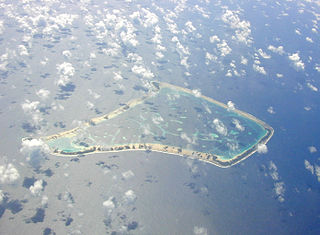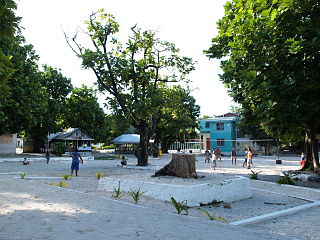Related Research Articles

Tokelau is a dependent territory of New Zealand in the southern Pacific Ocean. It consists of three tropical coral atolls: Atafu, Nukunonu, and Fakaofo. They have a combined land area of 10 km2 (4 sq mi). The capital rotates yearly among the three atolls. In addition to these three, Swains Island, which forms part of the same archipelago, is the subject of an ongoing territorial dispute; it is currently administered by the United States as part of American Samoa. Tokelau lies north of the Samoan Islands, east of Tuvalu, south of the Phoenix Islands, southwest of the more distant Line Islands, and northwest of the Cook Islands.

Fakaofo, formerly known as Bowditch Island, is a South Pacific Ocean atoll located in the Tokelau Group. The actual land area is only about 3 km2, consisting of islets on a coral reef surrounding a central lagoon of some 45 km2. According to the 2006 census 483 people officially live on Fakaofo. Of those present 70% belong to the Congregational Church and 22% to the Catholic Church.
Naturally occurring erbium (68Er) is composed of 6 stable isotopes, with 166Er being the most abundant. 39 radioisotopes have been characterized with between 74 and 112 neutrons, or 142 to 180 nucleons, with the most stable being 169Er with a half-life of 9.4 days, 172Er with a half-life of 49.3 hours, 160Er with a half-life of 28.58 hours, 165Er with a half-life of 10.36 hours, and 171Er with a half-life of 7.516 hours. All of the remaining radioactive isotopes have half-lives that are less than 3.5 hours, and the majority of these have half-lives that are less than 4 minutes. This element also has numerous meta states, with the most stable being 167mEr.

The office of head of government of Tokelau, often simply called the Ulu, rotates yearly between the faipule (leaders) of Tokelau's three atolls: Atafu, Fakaofo, and Nukunonu. The current Ulu is Siopili Perez, the Faipule of Nukunonu atoll, who has held the position since May 2022.

Thyroid dysgenesis is a cause of congenital hypothyroidism where the thyroid is missing, ectopic, or severely underdeveloped. It should not be confused with iodine deficiency, or with other forms of congenital hypothyroidism, such as thyroid dyshormonogenesis, where the thyroid is present but not functioning correctly.

A total lunar eclipse will take place on April 26, 2051.
Mulifenua is an islet of the Fakaofo island group of Tokelau.
Lalo is an islet of the Fakaofo island group of Tokelau.
Matangi is an islet of the Fakaofo island group of Tokelau.
Saumatafanga is an islet of the Fakaofo island group of Tokelau.
Nukulakia is an islet of the Fakaofo island group of Tokelau.
Nukumatau is an islet of the Fakaofo island group of Tokelau.
Teafua is an islet of the Fakaofo island group of Tokelau.

Fenua Fala is an islet of the Fakaofo island group of Tokelau. A settlement Fakaofo was established there in 1960.

Tokelau has two official languages: Tokelauan and English. Over 90% of the population speaks Tokelauan, and just under 60% speak English. Also, 45.8% of the population speak Samoan, and small percentages of the population speak Tuvaluan and Kiribati.

A partial solar eclipse will occur on Tuesday, April 11, 2051. A solar eclipse occurs when the Moon passes between Earth and the Sun, thereby totally or partly obscuring the image of the Sun for a viewer on Earth. A partial solar eclipse occurs in the polar regions of the Earth when the center of the Moon's shadow misses the Earth.
Awtano is a member of the Fakaofo island group of Tokelau.

Zachód is one of four districts of Szczecin, Poland situated on the left bank of Oder river in western part of the city. As of January 2011 it had a population of 116,232.

Stein 2051 is a nearby binary star system, containing a red dwarf and a degenerate star, located in constellation Camelopardalis at about 18 ly from Earth.
Temple University Hospital (TUH) in Philadelphia, Pennsylvania is an academic medical center in the United States which is a part of the healthcare network Temple Health. It is the chief clinical training site for the Temple University School of Medicine. The hospital currently has a 722-bed capacity that offers comprehensive inpatient and outpatient services to the surrounding community, and highly specialized tertiary services in the Delaware Valley. In 2015, Temple University Hospital had more than 84,000 emergency department and 200,000 outpatient visits.
References
Coordinates: 9°26′24″S171°12′18″W / 9.4399°S 171.2051°W